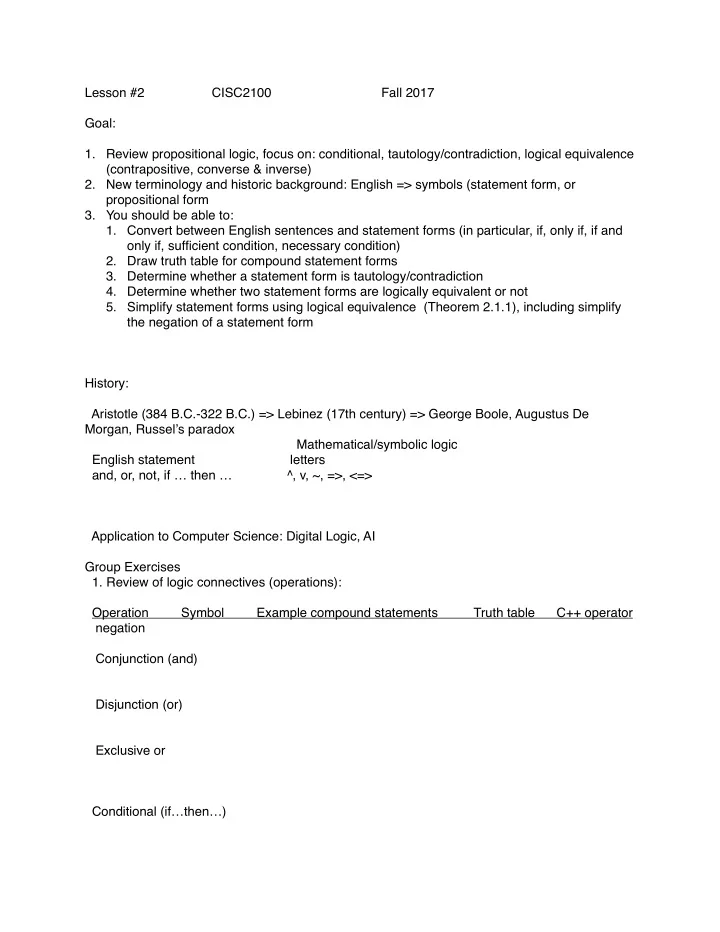

Lesson #2 � � CISC2100 � � � Fall 2017 � � Goal: � � 1. Review propositional logic, focus on: conditional, tautology/contradiction, logical equivalence (contrapositive, converse & inverse) � 2. New terminology and historic background: English => symbols (statement form, or propositional form � 3. You should be able to: � 1. Convert between English sentences and statement forms (in particular, if, only if, if and only if, sufficient condition, necessary condition) � 2. Draw truth table for compound statement forms � 3. Determine whether a statement form is tautology/contradiction � 4. Determine whether two statement forms are logically equivalent or not � 5. Simplify statement forms using logical equivalence (Theorem 2.1.1), including simplify the negation of a statement form � � � � History: � � Aristotle (384 B.C.-322 B.C.) => Lebinez (17th century) => George Boole, Augustus De Morgan, Russel’s paradox � � � � � � Mathematical/symbolic logic � English statement � � letters � and, or, not, if … then … � ^, v, ~, =>, <=> � � � � Application to Computer Science: Digital Logic, AI � � Group Exercises � 1. Review of logic connectives (operations): � � Operation Symbol Example compound statements Truth table C++ operator � negation � � Conjunction (and) � � � Disjunction (or) � � � Exclusive or � � � � Conditional (if…then…) � �
Biconditional � � � Order of operations (precedence level) � ~ first, � ^ next, � V next � —>, <—> next � � 2. English statement to statement form � � A statement form (or propositional form) is an expression made up of statement variables (such as p, q, and r) and logical connectives (such as above) that becomes a statement when actual statements are substituted for the component variables. � � For example, p => q, if p is substituted with “you show up on Monday for work”, q with “you get the job”, p=>q becomes a statement “if you show up on Monday for work, then you get the job. � � if p is substituted with “it rains”, q with “the ground is wet”, then …. � � � We can say the above two statements have same form. � � � Exercise: What’s the statement forms of the following statement: “John is not 6 feet tall or he weight less than 200 pounds”. � � � � � � “1<x<=40” where x stands for a particular variable whose value is 3 � � � � � � � 3. Review: Tautology and contradiction, logical equivalence � � Common tool: write truth-tables for the statement form � a) identify variables, one column per variable � b) one column per � � � Example. ~(p^q)= ~p ^ ~q � � � Exercise: p->q = ~q V p �
� � Exercise: distributive law � � Exercise: p->q = ~q -> ~p � � � � p->q =? ~p -> ~q � � � � 4. Contrapositive, converse, inverse of a conditional statement � � Statement: if my car is in the repair shop, then I cannot get to class. � � p -> q � � 1) contrapositive: � � � � 2) converse � � � � 3) inverse � � � � � � 5. Summary of all logical equivalence � � 6. Usage of the logical equivalence: � � simplify a statement form, negate a statement form � � � � � �
Recommend
More recommend